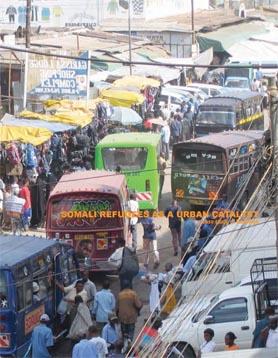Somali Refugee as a Urban Catalyst - A Case Study of Eastleigh

Students: Nino Soppelsa, Nicola Nett
Location: Group work in Nairobi
Date: December, 2007
Type: Research project, student work, Somalian Urban Refugee Community
Somalia has been engulfed in a civil war for the last 16 years. Since 1991, when the former Somali president Siad Barre was ousted from office by warlords, hundred thousands of Somalis have fled to Kenya. Having put up in refugee camps in the east of the country, many refugees have over time left the camps and made their way to Nairobi, where most of them settled in the neighborhood of Eastleigh. The inflow of Somalis, both refugees and other migrants, has been so strong, that today Somalis make up the overwhelming majority of the neighborhood, which used to be populated by Asian communities until Kenya’s independence. As of its Somali character and population, it has been labeled ‘Little Mogadishu’ in reference to the Somali capital.
The Amal Shopping Plaza in Eastleigh is probably the densest and most complex shopping mall in Nairobi. It was set up and developed by the Somalian urban refugee community, which dominate and shape this area of the city. Housed in a building which is full of ramps, winding staircases, columns, elevators, courtyards, platforms and open floor shopping areas, it seems like a physical embodiement of the frenzy of trading and negotiation.The building and its activities exhibit three overlaying scales of networking: On the scale of the building itself, the use of the spaces is a product of direct investment and community negotiations. Shop keepers can buy shares of the building, had the chance to invest in the business during the time of its construction, or simply pay monthly rents. The distribution of the shops within the space is controlled and ‘curated’ by the management and is also dependent on the financial investment of the storekeepers. An distinct economical pattern eixists within the building, dependent on floor level, proximity to access routes and staircases and clustering of specific trading goods. Within the city, the shopping mall is known for its very competitive prices and availability of products and commodities such as textiles and electronics. From all over town, Nairobi residents come to Eastleigh to shop in Amal Shopping Plaza, or in one of the many other similar types of shopping malls nearby, putting pressure on other shopping facilities in the city.
Download the Book PDF

